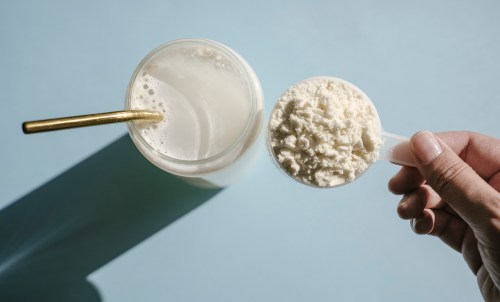About 30 million American adults have some degree of lactose intolerance by age 20, so it’s not surprising popular TikTok hashtags like #dairyfreerecipes and #dairyfreetips have amassed over 80 million views combined. But among the dairy-free conversation, a new trend has emerged on social media—one where more and more people are sharing how they can tolerate dairy products made in Europe that would normally result in unfavorable symptoms if consumed stateside.
Experts in This Article
There are some theories as to why this is, with the main one attributing the difference in food supply chain in the U.S. compared to Europe to be the primary culprit. While it is true that both countries have different approaches in handling food, specifically dairy, experts have explained how this is merely due to differences in risk management. Plus, there is a lack of scientific evidence validating this to be true as it pertains to dairy sensitivity, despite various personal experiences you may have heard from friends (or folks you follow on social media).
So if banned ingredients and food supply chain differences aren’t at play, then why are so many people claiming to tolerate dairy in Europe so much better than in their country? We sat down with a registered dietitian specializing in helping those with digestive disorders and dairy sensitivities as well as a food scientist to get some answers.
Why dairy can cause digestive discomfort
Before getting into why dairy sensitivities can vary, it’s important to know what about dairy can lead to an upset stomach or sudden trip to the bathroom. “The major reason dairy can lead to digestive issues is lactose intolerance, [which is when] the body is not producing enough lactase, the enzyme that breaks down lactose, which is the main carbohydrate in milk,” says Erin Judge, RDN, LDN, a registered dietitian nutritionist and founder of Gutivate, a nutrition counseling practice for digestive disorders. “The poor breakdown of lactose can lead to symptoms such as gas, bloating, cramping, pain, or diarrhea, but can vary by person.”
Judge also points out how it’s also possible to have an allergy-like response to the proteins in dairy, which can result in skin flushing, rashes, and more in addition to uncomfortable digestive symptoms.
How dairy in Europe differs from American dairy
Among the many social posts on this trend, there’s been a hyper focus on the differences in dairy and whether or not this is the cause for changes in dairy sensitivities. For one, you may see dairy on the shelves in grocery stores versus the refrigerated section in the United States. The reason for this is due to milk pasteurization methods. “Milk is pasteurized through a process called ultra high temperature (UHT) in Europe, which kills the bacteria and can lead to a longer shelf life product without refrigeration,” explains Natalie Alibrandi, a UK-based food scientist and CEO of Nali Consulting. America, on the other hand, follows a different method called high temperature, short time (HTST), which Alibrandi says kills most bacteria in dairy, but still requires refrigeration. Despite the differences in pasteurization methods, the lactose content is the same for HTST and UHT milk.
Another notable difference between milk in America and Europe (one of which has been known to cause controversy) is the allowance of recombinant bovine growth hormone (rGBH) that some believe can negatively impact humans. The main reason being is due to the fact that Europe banned the use of rBGH, while America has not. “RBGH has been approved by the FDA since 1993, however it’s been outlawed in the EU since 1990,” says Alibrandi. The concern the EU has on using rGBH is the known increase in hormone IGF-1 that can cause cells to grow which some believe is correlated with prostate cancer, breast cancer, and colorectal cancer, but the evidence of potential harm to humans is inconclusive.
It’s also important to note that 90 percent of rBGH is destroyed during pasteurization and even more can be destroyed during cooking processes. So while the use of rGBH may be concerning for some, there have been no discernible effects on humans as it pertains to dairy sensitivities when consumed through milk.
Why your dairy sensitivity may change in Europe, according to an expert
So now that we’ve touched on how European dairy differs from American dairy and how these differences probably aren’t contributing to the change in dairy sensitivities, you may be wondering what is at play.
To start, it’s important to remember that dairy can contain different levels of lactose content, depending on the level of fat in the food item. “Full-fat milk can have a lower lactose content than low-fat dairy options, so the lactose load may be more tolerable,” Alibrandi says. “Lactose-free milk is the only milk without lactose. This type of milk adds the enzyme lactase to break down lactose.” Restaurants can vary in the type of dairy used for various dishes, which can impact you differently, depending on your lactose intolerance.
Judge points out that there are other factors that have nothing to do with lactose content that may also be at play. “Other reasons for improved tolerance in other locations would be due to other digestive distress contributors, including other ingredients in dairy products, portions, movement or lack or movement, and stress levels,” says Judge.
On the movement note, trips to Europe may require walking more to get around versus driving a car, which can increase your levels of movement on a trip and ultimately help with overall digestion. While walking more may not seem like the biggest difference, one study points out how over a third of Americans prefer to drive rather than walk five minutes. The extra steps you normally wouldn’t take can help with breaking down food for your body to use, especially if walking right after a meal.
Another contributing factor that can lead to an improved tolerance of dairy products is your stress levels, which can be easily overlooked. In most instances, trips to Europe act as a vacation that allow you to get away from activities and environments currently associated with stress and anxiety. The reduction in stress can not only benefit your mental health, but your digestive health as well. “I find that many people are more relaxed and have less stress on vacation since they aren’t working or around their usual stressors, and this would improve digestion overall, even with foods that are not usually tolerated well,” says Judge. Eating gelato while shopping or sightseeing sounds pretty relaxing, no?
According to the Stress in America 2020 survey done by the American Psychological Association (APA), more than three in four adults (77 percent) say the future of our nation is a significant source of stress (which is up significantly from 2019 when 66 percent of adults said the same). It’s no wonder being in a new environment, especially one we’re excited to be in, can lead to a higher tolerance of ingredients that normally wreak havoc.
The bottom line
While there’s still no clear-cut answer as to why so many people report dairy sensitivity changes when traveling, it’s important to consider the various factors that can impact our digestion. Therefore, Judge suggests paying attention to the bigger picture when on vacation, such as your stress levels, body movement levels, and the lactose levels in dairy products. That way, it’s easier to determine what factors can influence how your body reacts to dairy, regardless of where you’re located.
Sign Up for Our Daily Newsletter
Get all the latest in wellness, trends, food, fitness, beauty, and more delivered right to your inbox.
Got it, you've been added to our email list.










